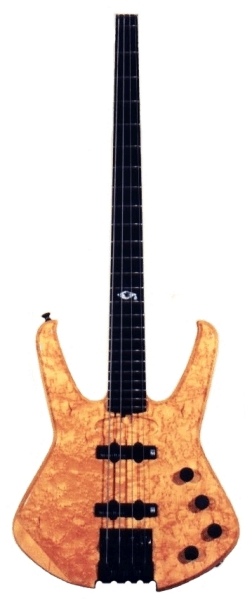

| |
When you first open the case of a guitar for review, it’s a bit like Pandora’s Box; what treasures (or terrors) lie beyond? In this instance a treasure indeed, for the KGB, snuggled in its plush-lined case, looked fit for a king – or rather a pharoah – as one of its most striking features is the solitary inlay on the fretboard, which depicts a teardrop in an eye and conjures up thoughts of ancient Egypt! |
 |
ConstructionA modern instrument this may be but it uses two of the most tried and trusted woods in guitar manufacturing – maple and ebony. The maple neck is extended to become part of the body, which is essentially three pieces. This is faced fron and back, with birds eye maple, giving that old gold appearance that many of us find particularly appealing. The fretboard is ebony, its matt black providing the ideal contrast to the body, whose hardware is also finished in black, giving an uncluttered look to this lovely instrument. The general lack of flash also makes the teardrop inlay all the more impressive, with its glittering abalone and mother-of-pearl staring at you out of the void. There are position markers inlaid on the fretboard edge and the neck tapers down to a stainless steel string anchor. With twenty four frets this guitar has a full 34” scale length, but the deep cutaway body means every note is easily accessible. There are four rotary controls, and running from neck to bridge we have: panning between pickups, volume, neck pickup tone and , finally, bridge pickup tone. All seem to be of high quality, sensitivity and performance. The ABM bridge assembly features string rollers, rather than static saddles, and the tailpiece houses the rotary tuners typical of the headless variety of basses. Tuning is a pleasure with this low friction combination. The two pickups are ‘Active EQ System Bass’ made by Seymour Duncan. These are the ones with three switches on the pickup face, which provide the large range of tonal quality and attack that the modern bass player requires. They are sensitive and powerful, and by altering the switch settings, their characteristics can be dramatically altered.
|
In useThis guitar is very comfortable to wear, standing or sitting, and the contoured body fits the player well. The absence of a headstock makes for an overall smaller instrument, creating an extremely good balance and – as it comes complete with straplocks – keeping things very secure. I found the string spacing particularly suited to finger playing and slapping, the general layout of the hardware looks and feels very natural and I particularly liked the way the controls follow the line of the body. The neck is very smooth – partly thanks to the ebony fretboard, which can make the playing very fast if desired. Curiously, the teardrop inlay sits at the fourteenth fret, and being so striking it’s easy at first to mistake it for the octave marker – which is actually on the edge of the fretboard. Consequently, this can be a little confusing to start with. The stainless steel string anchor is purely functional but it does blend in surprisingly well with the decorative inlay. The KGB’s sound quality is excellent, with good sustain and string balance across the whole neck. The variety of tone and colour is somewhat excessive, with the most subtle of setting changes giving even more range. The pickups do need to be set up prior to playing, as their switches are not easily accessed in a hurry, but the tone controls are responsive enough to more than make up for this. The pan pot really does make a good job of intermixing the pickups, and acts as a finishing touch to the overall sound, and the more I experimented the more variations became apparent. ConclusionI have to say that this bass has been a joy to play, in all respects, as well as a pleasure to look at. However, I must admit to having always been partial to the maple/ebony combination for both feel and appearance. This guitar just oozes quality from every grain and winding, it’s a custom-built machine – so left-handers fear not – and it works impressively.
|
|
|
|
Review by Roger Newell. |
 |